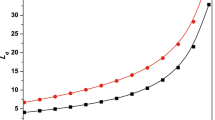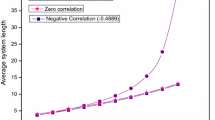Abstract
This paper analyzes a finite-buffer queueing system, where customers arrive in batches and the accepted customers are served in batches by a single server. The service is assumed to be dependent on the batch-size and follows a general bulk service rule. The inter-arrival times of batches are assumed to be correlated and they are represented through the batch Markovian arrival process (BMAP). Computation procedure of the queue-length distributions at the post-batch-service completion, an arbitrary, and the pre-batch-arrival epochs are discussed. Various performance measures along with the consecutive customer loss probabilities are studied considering batch-size-dependent renewal service time distributions. Further, the above finite-buffer bulk-service queueing model is also investigated considering correlated batch-service times which are presented through the Markovian service process (MSP). The phase-dependent consecutive loss probabilities for the correlated batch-service times are determined. In the form of tables and graphs, a variety of numerical results for different batch-service time distributions are presented in this paper.











Similar content being viewed by others
References
Baetens J, Steyaert B, Claeys D, Bruneel H (2018a) Delay analysis of a two-class batch-service queue with class-dependent variable server capacity. Math Methods Oper Res 88(1):37–57
Baetens J, Steyaert B, Claeys D, Bruneel H (2018b) Delay analysis of a variable-capacity batch-server queue with general class-dependent service times. In: AIP conference proceedings (vol 1978, p 190003). AIP Publishing
Banerjee A, Gupta UC (2012) Reducing congestion in bulk-service finite-buffer queueing system using batch-size-dependent service. Perform Eval 69(1):53–70
Banerjee A, Gupta UC, Chakravarthy SR (2015) Analysis of a finite-buffer bulk-service queue under Markovian arrival process with batch-size-dependent service. Comput Oper Res 60:138–149
Banik AD (2009) Queueing analysis and optimal control of \(BMAP/G^{(a, b)}/1/N\) and \(BMAP/MSP^{(a, b)}/1/N\) systems. Comput Ind Eng 57(3):748–761
Banik AD, Chaudhry ML (2017) Efficient computational analysis of stationary probabilities for the queueing system \(BMAP/G/1/N\) with or without vacation(s). INFORMS J Comput 29(1):140–151
Banik AD, Ghosh S (2019) Efficient computational analysis of non-exhaustive service vacation queues: \(BMAP/R/1/N(\infty )\) under gated-limited discipline. Appl Math Model 68:540–562
Banik AD, Ghosh S, Chaudhry ML (2019) On the consecutive customer loss probabilities in a finite-Buffer renewal batch input queue with different batch acceptance/rejection strategies under non-renewal service. In: Bansal J, Das K, Nagar A, Deep K, Ojha A (eds) Soft computing for problem solving, vol 816. Advances in Intelligent Systems and Computing. Springer, Singapore, pp 45–62
Bocharov PP (1996) Stationary distribution of a finite queue with recurrent input and Markov service. Autom Remote Control 57(9):1274–1283
Chaudhry ML, Templeton JGC (1983) First course in bulk queues. Wiley
Cidon I, Khamisy A, Sidi M (1993) Analysis of packet loss processes in high-speed networks. IEEE Trans Inf Theory 39(1):98–108
Cinlar E (2013) Introduction to stochastic processes. Courier Corporation
Claeys D, Steyaert B, Walraevens J, Laevens K, Bruneel H (2013) Analysis of a versatile batch-service queueing model with correlation in the arrival process. Perform Eval 70(4):300–316
Claeys D, Steyaert B, Walraevens J, Laevens K, Bruneel H (2013) Tail probabilities of the delay in a batch-service queueing model with batch-size dependent service times and a timer mechanism. Comput Oper Res 40(5):1497–1505
De Boer PT (2000) Analysis and efficient simulation of queueing models of telecommunication systems. Ph.D. thesis, Centre for Telematics and Information Technology University of Twente
Gelenbe E, Lent R (2013) Computer and information sciences III. Springer
Grassmann WK, Taksar MI, Heyman DP (1985) Regenerative analysis and steady state distributions for Markov chains. Oper Res 33(5):1107–1116
Kant L, Sanders WH (1997) Analysis of the distribution of consecutive cell losses in an ATM switch using stochastic activity networks. Comput Syst Sci Eng 12(2):117–129
Lee CW, Andersland MS (1996) Consecutive cell loss controls for leaky-bucket admission systems. In: Global telecommunications conference, 1996. GLOBECOM’96.’Communications: the key to global prosperity (vol 3, pp 1732–1738). IEEE
Li QL (2011) Constructive computation in stochastic models with applications: the \(RG\)-factorizations. Springer
Li QL, Lian Z, Liu L (2005) An \(RG\)-factorization approach for a \(BMAP/M/1\) generalized processor-sharing queue. Stoch Models 21(2–3):507–530
Lucantoni DM (1991) New results on the single server queue with a batch Markovian arrival process. Commun Stat. Stoch Models 7(1):1–46
Lucantoni DM, Neuts MF (1994) Some steady-state distributions for the \(MAP/SM/1\) queue. Stoch Models 10(3):575–598
Lynd LR, Weimer PJ, Van Zyl WH, Pretorius IS (2002) Microbial cellulose utilization: fundamentals and biotechnology. Microbiol Mol Biol Rev 66(3):506–577
Neuts MF (1967) A general class of bulk queues with Poisson input. Ann Math Stat 38(3):759–770
Neuts MF (1979) A versatile Markovian point process. J Appl Probab 16(04):764–779
Pacheco A, Ribeiro H (2006) Consecutive customer loss probabilities in \(M/G/1/n\) and \(GI/M(m)//n\). In: Proceedings of workshop on tools for solving structured Markov chains (SMCtools’06), Pisa, Italy
Pacheco A, Ribeiro H (2008) Consecutive customer losses in oscillating \(GI^X/M//n\) systems with state dependent services rates. Ann Oper Res 162(1):143–158
Pacheco A, Ribeiro H (2008) Consecutive customer losses in regular and oscillating \(M^X/G/1/n\) systems. Queueing Syst 58(2):121–136
Posten C (2009) Design principles of photo-bioreactors for cultivation of microalgae. Eng Life Sci 9(3):165–177
Powell WB (1985) Analysis of vehicle holding and cancellation strategies in bulk arrival, bulk service queues. Transp Sci 19(4):352–377
Pradhan S, Gupta UC (2017) Modeling and analysis of an infinite-buffer batch-arrival queue with batch-size-dependent service. Perform Eval 108:16–31
Pradhan S, Gupta UC (2019) Analysis of an infinite-buffer batch-size-dependent service queue with Markovian arrival process. Ann Oper Res 277:161–196
Ramaswami V (1980) The \(N/G/1\) queue and its detailed analysis. Adv Appl Probab 12(1):222–261
Takine T, Suda T, Hasegawa T (1995) Cell loss and output process analyses of a finite-buffer discrete-time ATM queueing system with correlated arrivals. IEEE Trans Commun 43(234):1022–1037
Acknowledgements
The authors are thankful to the reviewers for their valuable comments which have led to significant improvements of the paper. The first author is partially supported by the Israeli Science Foundation (Grant No. 1571/19).
Author information
Authors and Affiliations
Corresponding author
Ethics declarations
Conflict of interest
The authors declare that they have no conflict of interest.
Additional information
Publisher's Note
Springer Nature remains neutral with regard to jurisdictional claims in published maps and institutional affiliations.
A part of this research work was presented in the 51st Annual Convention of ORSI and International Conference (ORSI-2018) in Mumbai hosted by the ORSI-Mumbai Chapter and IIT Bombay as “A Brief Note on Analytical Aspects and Consecutive Losses in Finite-buffer Queues under Batch-size-dependent/Non-renewal Bulk-service and Batch Markovian Arrival Process”
Rights and permissions
About this article
Cite this article
Ghosh, S., Banik, A.D., Walraevens, J. et al. A detailed note on the finite-buffer queueing system with correlated batch-arrivals and batch-size-/phase-dependent bulk-service. 4OR-Q J Oper Res 20, 241–272 (2022). https://doi.org/10.1007/s10288-021-00478-x
Received:
Revised:
Accepted:
Published:
Issue Date:
DOI: https://doi.org/10.1007/s10288-021-00478-x
Keywords
- Finite-buffer queue
- Batch Markovian arrival process (BMAP)
- Markovian service process (MSP)
- Batch-size-dependent bulk service
- Performance measures
- Consecutive customer loss (CCL)




